#World premiere for the #Divo: #Bugatti unveils its latest model in California at the exclusive event “The Quail – A Motorsports Gathering”
Text in Deutsch. Bitte scrollen.
-
- Bugatti President Stephan Winkelmann: “The Divo has significantly higher performance in terms of lateral acceleration, agility and cornering. The Divo is made for corners.”
-
- Sophisticated aerodynamics programme, modifications to chassis and suspension as well as weight reduction make the Divo a star performer on corners
-
- 35 kg (77 lbs) lighter than the Chiron
-
- Higher lateral acceleration of 1.6 g
-
- 90 kg (198 lbs) more downforce than the Chiron
-
- Maximum speed limited to 380 km/h (236 mph)
-
- 8 seconds faster lap time on the Nardò handling circuit
-
- New progressive design language underlines the inner values of the Divo
-
- Divo is the modern interpretation of Bugatti’s coachbuilding tradition
-
- Divo to be homologated as a road vehicle
-
- Strictly limited small series of 40 vehicles already sold out
- Net unit price: €5 million
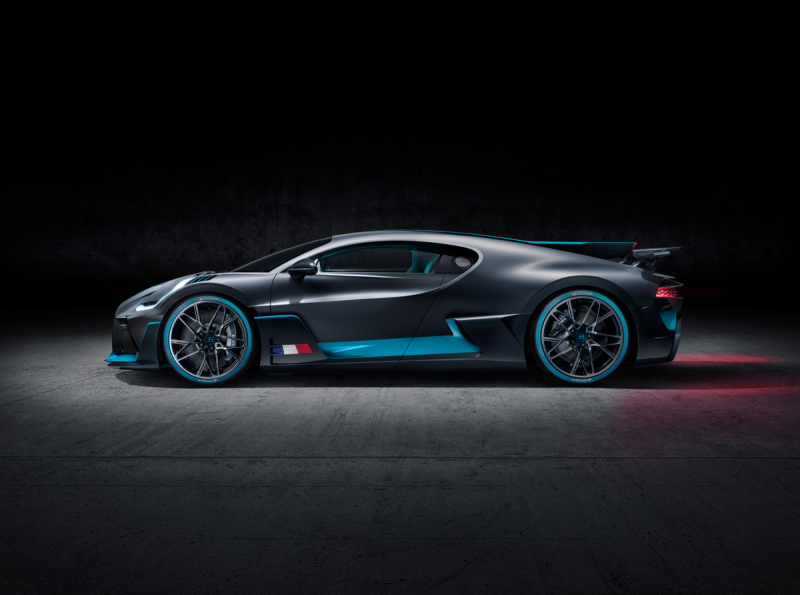
Curtains up for the Divo. Bugatti has presented its latest model as a world premiere, at the exclusive automotive event “The Quail: A Motorsports Gathering“ in Monterey, California. With the Divo, the French luxury brand has developed a super sports car tuned for agility, nimbleness and optimum handling performance on winding roads. It is powered by Bugatti’s iconic eight-litre W16 engine with a power output of 1,500 PS. The aerodynamics of the model have been intensively fine-tuned and the suspension and chassis settings have been modified. As a result, the Divo is 35 kilograms (77 lbs) lighter and has 90 kilograms (198 lbs) more downforce than the standard Chiron2. The lateral acceleration of the Divo has been boosted to 1.6 g. Its maximum speed is limited to 380 km/h (236 mph). The Divo can lap the Nardò handling circuit in southern Italy eight seconds faster than the Chiron. The series will only consist of 40 vehicles. Upon the start of presentations to selected customers, the strictly limited small series, with a net unit price of €5 million, sold out immediately.
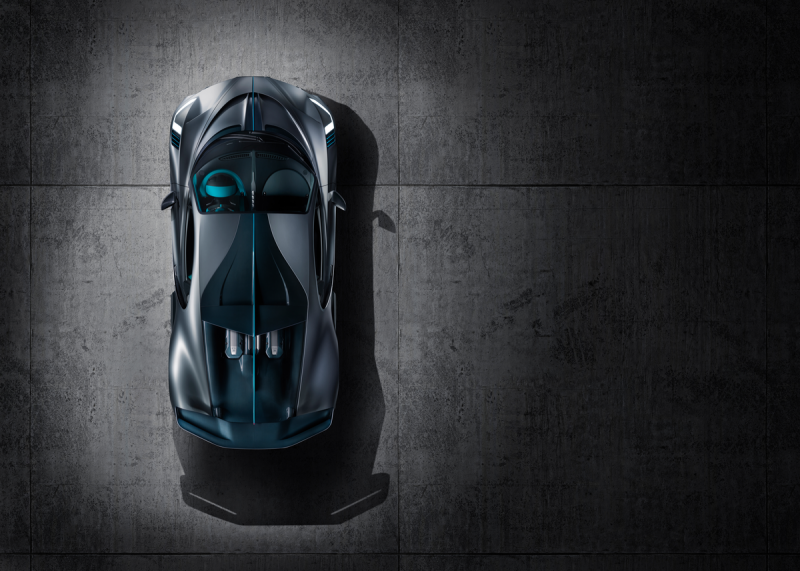
“When I took up my position at Bugatti at the beginning of the year, I soon learnt that our customers and fans were waiting for a special vehicle which would tell a further story for the brand in addition to the Chiron,” said Stephan Winkelmann, President of Bugatti Automobiles S.A.S. “The Bugatti team was also very eager to implement a project like this.”
It was therefore decided to build a super sports car with a different character from the Chiron which would still be immediately recognizable as a Bugatti.
With the Divo, Bugatti is also reviving its coachbuilding tradition. In its first few decades, the French luxury brand had considerable success with bodies built to its own design and installed on existing chassis.
“To date, a modern Bugatti has represented a perfect balance between high performance, straight-line dynamics and luxurious comfort. Within our possibilities, we have shifted the balance in the case of the Divo further towards lateral acceleration, agility and cornering,” Winkelmann added. “The Divo is made for bends.“
“The feedback from our customers was overwhelming,” the Bugatti President reports. “We showed the Divo to a small group of selected Chiron customers. All 40 cars were sold immediately – this was fantastic confirmation for the Bugatti team which had put so much dedication and passion into the project.”
“The Divo is a further project intended to thrill people and the world,” Winkelmann adds. “Our fans are very important to us.”
The supercar is named after Albert Divo, a French racing driver who was a two-time winner of the famous Targa Florio race on the mountainous roads of Sicily with Bugatti in the late 1920s.
The Divo represents the modern interpretation of the brand’s coachbuilding tradition
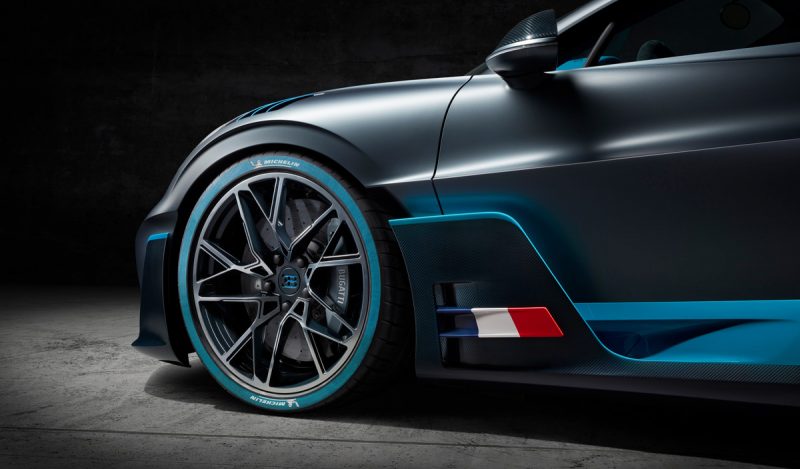
“The modern interpretation of coachbuilding gave us engineers new freedom,” says Stefan Ellrott, Head of Technical Development at Bugatti. “The step that we have taken with the Divo in terms of agility and high-performance cornering dynamics can be compared with the overall development from the Veyron to the Chiron.“
A sophisticated aerodynamics programme makes for optimum vehicle cooling and 90 kilograms more downforce.
The aerodynamic properties of the Divo were improved by a considerable amount of detailed work. The front cover is equipped with air intakes which reduce the effective cross-sectional area of the vehicle at the same time as ensuring improved air flow at the front and increasing aerodynamic efficiency. An optimized “air curtain” makes for better air flow over the front and rear sections of the car’s sides.

The newly-designed, wide front spoiler provides higher downforce and guides more air to the front air inlets. The cooling system therefore receives a higher mass flow and overall cooling performance is improved.
The brakes are cooled by four independent air sources on each side of the vehicle: air flows in from the high-pressure area above the front bumper, the inlets on the front wings, one inlet on the front radiator and the diffusers ahead of the tyres. Vanes direct the cold air from these areas onto the brake discs. A heat shield carries the hot air out through the wheels. This means that the brakes do not overheat and the tyre temperature is always kept in the optimum range. This system, which is already used on the Chiron, receives additional support from the vacuum generated by the air curtain on the tyres in the case of the Divo. In addition, the wheel arches are ventilated via slats on the wings.

The roof of the Divo has been designed to form a NACA air duct, a flow-optimized air inlet. In combination with the specially designed engine compartment cover, this ensures a very high air mass flow to the engine compartment, playing a key role in temperature management in this area of the vehicle.
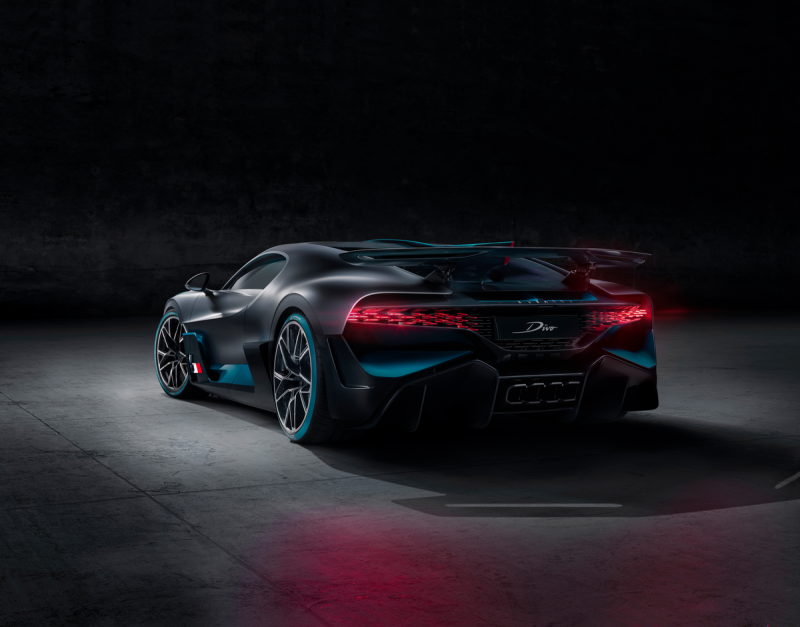
The rear end of the Divo features a new, height-adjustable rear spoiler which functions as an air brake when turned forwards and is set to different angles for the individual driving modes. The rear spoiler has a width of 1.83 metres (72”) and is therefore 23 percent wider than on the Chiron. The wider spoiler improves efficiency and results in higher air brake performance as well as significantly more downforce.
The downforce is also boosted by the rear diffuser which has been entirely redesigned for greater efficiency and accommodates four tailpipes.
The total downforce generated is 456 kilograms, 90 kg more than on the Chiron.
New chassis and suspension settings as well as weight reduction make the Divo a star performer on corners
The main objective of chassis development work was to improve cornering dynamics; the Divo was to be sharper, more agile and more nimble. For this purpose, the camber was increased. As a result the maximum speed of the Divo is limited to 380 km/h. In contrast to the Chiron, there is therefore no Top Speed mode. As regards lateral acceleration, the Divo reaches 1.6 g. These changes alone ensure a perceptibly different driving experience on winding roads.
The steering and suspension have been set to ensure more direct response and significantly sportier driving behaviour in all modes (EB, Autobahn and Handling). The Divo is 35 kilograms lighter than the Chiron. The weight reduction is the result of a number of design modifications including new lightweight wheels and a carbon fibre intercooler cover. Weight was also saved by the fixing of the front diffuser flaps, a reduction in the amount of insulation material used and the installation of a lighter sound system. In order to reduce the weight, stowage compartments on the central console and in the door trims have also been omitted. The Divo can therefore lap the Nardò handling circuit eight seconds faster than the Chiron.
Form follows Performance
New progressive design language underlines the inner values of the Divo. A new suit of clothes for a new character
“The Divo is a further example of our design philosophy ‘Form follows Performance‘. In this case, the engineers and designers aimed to create a vehicle focusing on cornering speeds and lateral dynamics,” says Achim Anscheidt, Director of Design of Bugatti Automobiles S.A.S., describing the design language of the new Bugatti.
“The Divo project was also a welcome opportunity for our team to add a modern chapter to the coachbuilding story of Bugatti which had been so successful in the early years of the brand.”
“Our task was to develop a vehicle which would look different from the Chiron but still be immediately recognizable as a Bugatti,” Anscheidt adds. “For us designers, this meant that the three key style elements of Bugatti had to remain in place: the horseshoe-shaped front grille, the typical Bugatti signature line along the sides of the vehicle and the characteristic fin that defines the longitudinal axis of the car when viewed from above, which was derived from the Type 57 Atlantic.”
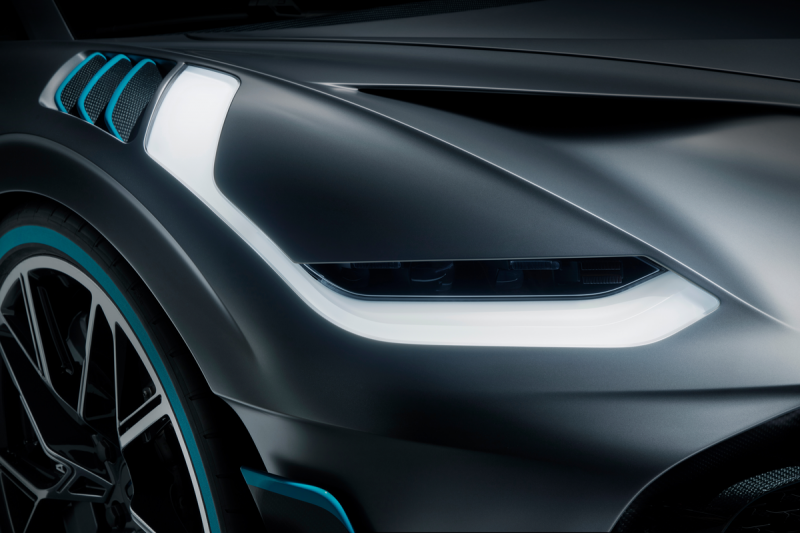
The design team continued the evolution of the design elements for the Divo in line with the design brief and reinterpreted the design philosophy “Form follows Performance”. The outer skin of the Divo was designed in an uncompromising way to emphasize lateral acceleration. The main objective was to achieve optimum aerodynamic and thermodynamic efficiency. At the same time, the Divo represents a new styling approach which the design team has developed especially for a coachbuilt Bugatti and which is distinguished from the modern core products of the brand.

The slimmer side line of the Divo helps make the vehicle look lower and longer. The new proportions allow a visual horizontal division of the body, which is reinforced by a special colour scheme. The top, more elegant section is painted with a matt finish in a silver colour “Titanium Liquid Silver” developed especially for the Divo. This effectively underpins the sculptural, muscular form of the car. The long domed areas with their smooth surfaces along the C-pillar and the rear side sections optically shift the driver’s cab forwards. This gives the Divo an extremely dynamic appearance even when the vehicle is standing still.
The lower part of the sides has more of a functional, technical design, reinforcing the car’s forceful appearance and giving it a confident stance on the road. This section features exposed carbon fibre tinted in a petroleum blue shade, “Divo Carbon”, developed especially for this model.
An entirely new architecture was developed for the front of the car. There are additional air inlets for brake cooling. The new, vertically oriented front lights with daytime running light on the outer edge in each case give the Divo an appearance of greater width. With a light opening which is only 35 millimetres (1 3/8“) flat, the extremely compact, lightweight LED headlights move into a new technical dimension. A light animation developed especially for the Divo underlines the distinctive signature of the front end. The horizontal split into a lower carbon and an upper matt silver section also makes the Divo look lower and underlines the optical impression of width.
The NACA air inlet on the roof creates an optical connection with the air outlet in the centre of the front cover and guides the air towards the rear spoiler. The fact that the central line runs from the front over the roof to the rear spoiler is not only a reminiscence of Bugatti’s legendary past but also serves a function. This configuration prevents air eddies from forming over the vehicle, creating turbulence on the rear spoiler.
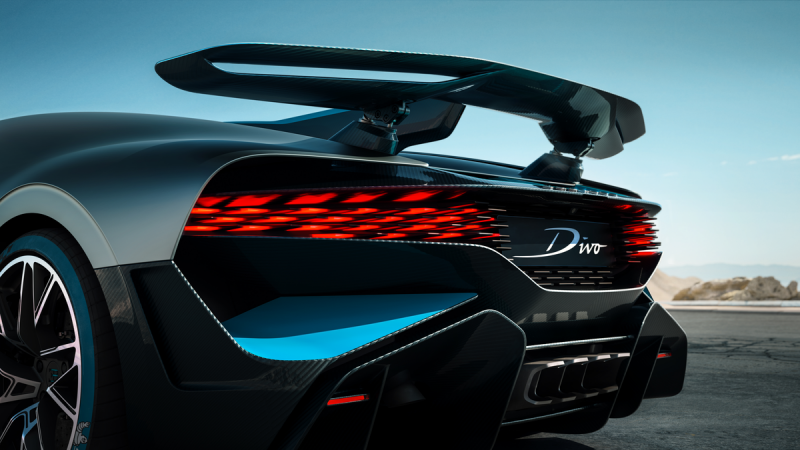
One highlight at the rear of the vehicle is definitely the new, highly sophisticated 3-D rear light. This is actually part of the rear grille, which is partly produced by a 3-D printing process and has special lightweight fins with a variety of sizes. A total of 44 of these fins light up, forming the rear light of the Divo. At the outer edge, the fins become wider, creating a more intensive light. Towards the centre of the vehicle, they are narrower, resulting in gradual fading of the light. The result is a striking appearance which means that the Divo is also unmistakable from the rear.
The two-tone colour scheme also intensifies the forceful impression created by the rear. The fenders are painted in “Titanium Liquid Silver” with a matt finish and are optically distinguished from the parts which control airflow at the rear end. Air outlets, rear spoiler and diffuser have a carbon finish.
“Divo Racing Blue”, a bright turquoise blue shade developed especially for the Divo, underlines the three-dimensional character of the three surfaces leading to the air inlets and outlets on the front, sides and rear, creating dynamically contrasting effects.
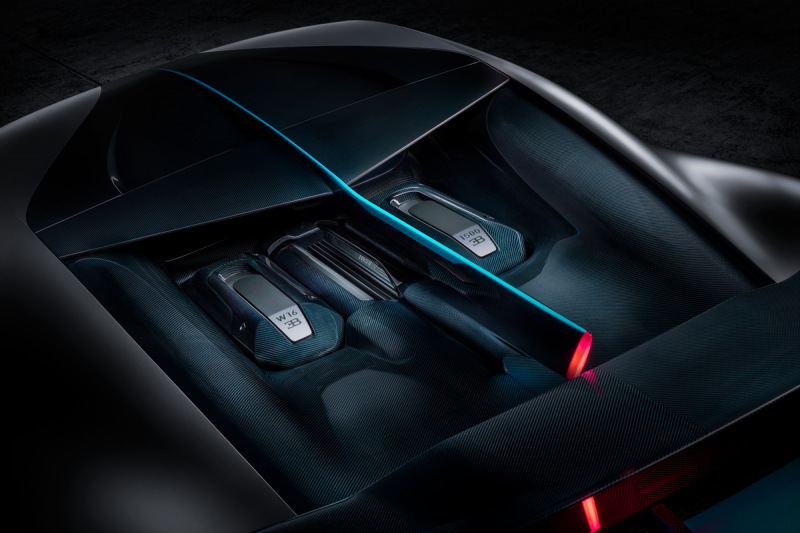
The technical character of the colour scheme and materials used for the exterior is continued in the interior. A matt version of the exclusive high-gloss carbon fibre used on the exterior is to be found in the interior.
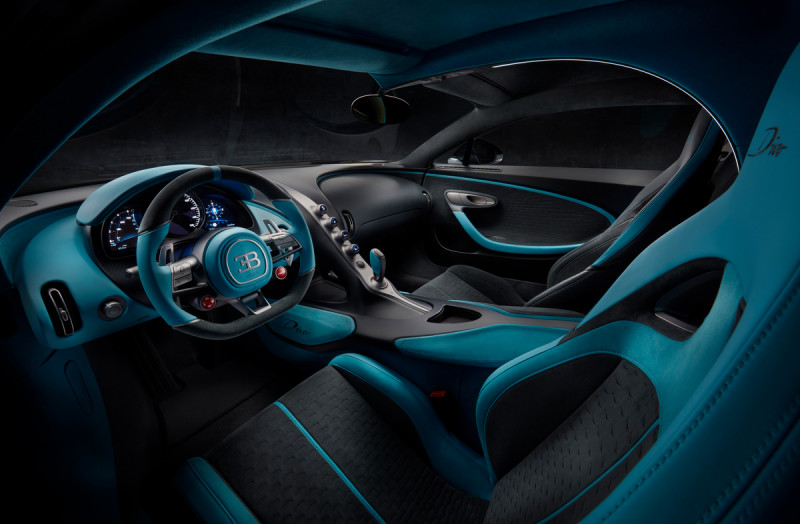
The colour effects of the carbon tint and exterior paintwork are reflected on a 1:1 basis by the dark “Divo Grey” petroleum tone of the Alcantara in the interior, providing a subtle contrast with the glass-blasted anodized grey surfaces of the metal parts.

The distinctive “Divo Racing Blue” is also used as an Alcantara leather tone in the interior, where it plays a special role by providing an optical split in the interior surfaces. This colour is used almost throughout the driver’s section while it only provides selected accents in the darker passenger’s section.
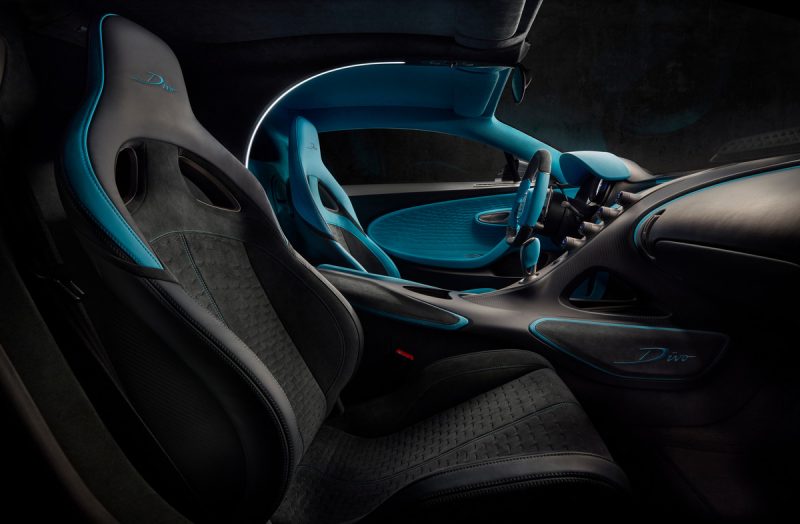
Another stylistic link between interior and exterior is created by the door trims and seat areas, which feature an embroidered three-dimensional rhomboid structure with an algorithmic configuration, reinterpreting the structure of the grille and rear lights.
Technical innovations in the interior include the seats, which not only feature a new design but offer greater lateral support. The steering wheel is partly covered with Alcantara and has larger paddles fitted firmly on both sides of the wheel. Thanks to larger armrests and calf supports, the central console ensures greater comfort.
Car named after French racing driver and two-times Targa Florio winner Albert Divo
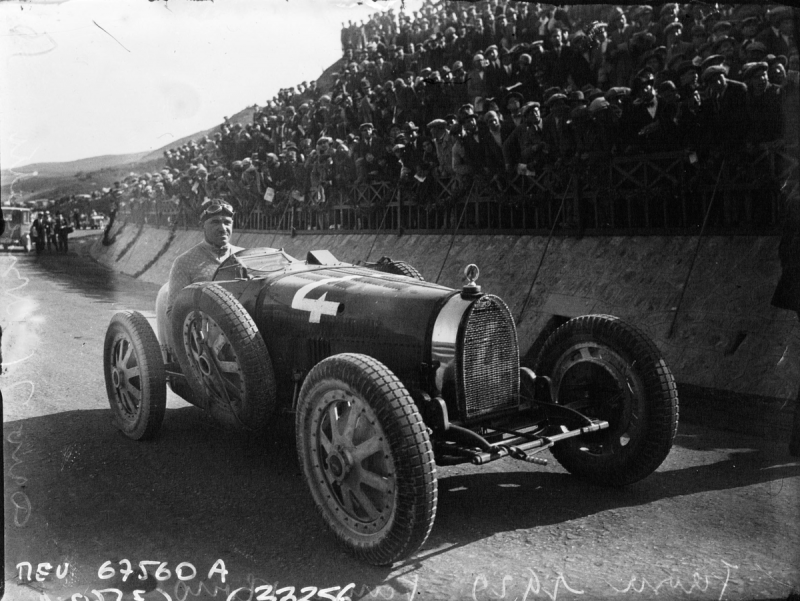
Albert Divo was born in Paris on 24 January 1895 under the name of Albert Eugène Diwo (he called himself Divo later). After service as a fighter pilot in the First World War, he worked as a mechanic. His career as a racing driver started with Sunbeam and Talbot-Darracq in 1919. He enjoyed rapid success and won the 1923 Spanish Grand Prix in Sitges In 1924, he moved to Delage and entered a number of sprint races in France. In 1926 and 1927, he again raced for Talbot, where he was less successful as a result of problems with an insufficiently mature design. He then returned to Delage but was not entered for any races. When Talbot and Delage retired from racing, Divo joined Bugatti’s works team in 1928. The same year, he won the Targa Florio in Sicily driving a Type 35 B. He repeated this success the following year. He took third place at Spa in 1930. Up to 1933 he entered further races for Bugatti with the Types 51, 53 and 54, as well as hillclimbs with the Types 45 and 47. From 1936, he raced for Delahaye and Talbot. He retired from racing in 1939. Following the Second World War, Albert Divo worked as racing manager for Castrol. In 1962, he was a founder member of the Club International des Anciens Pilotes de Grand Prix F1 in Villars-sur-Ollon (Switzerland). Divo received the Legion of Honour. He then led a withdrawn life and died in Morsang-sur-Orge to the south of Paris on 19 November 1966.
Divo definitely celebrated his greatest success with Bugatti, whose dominance of the Targa Florio started in 1925. The legendary Targa Florio, held on a mountain circuit in Sicily each year until 1977, was certainly one of the most arduous of all the endurance races of its time. Bugatti won the race five times in succession with the Type 35.
Bugatti coachbuilding: factory coachwork made in Molsheim

With the Divo, Bugatti is reviving its coachbuilding tradition. While Ettore Bugatti’s vehicles of the 1920s represented lightweight design and technical innovation, it was his son Jean who made the Bugatti bodies of the 1930s into style icons of their time. To this day, Jean’s creations embody the golden era of French coachbuilding. In their own way, father and son both contributed to the very special myth of the Bugatti marque.
In the mid 1920s, Ettore Bugatti involved his son more and more in the business of the company and it was Jean who developed concepts for Bugatti bodywork, first for the Type 41 Royale and, from 1926, also for the Type 40. Up to that point, two-seater and four-seater sports convertibles and coupés had been made by coachbuilders such as Gangloff or Lavocat & Marsaud. In order to realize his ideas, Jean engaged the services of talented body designer Joseph Walter.
It was Walter who put Jean’s ideas into practice and developed the classical Bugatti coachbuilding tradition with the Grand Sport bodies for Types 40 and 43 through to the Type 57 bodies of the 1930s. For the Type 57, various bodies such as Stelvio, Aravis, Galibier, Ventoux or Atalante could be ordered as factory options. The best-known coachbuilt creations from Bugatti were definitely the streamlined Type 50, the Type 55 roadster and the Type 57SC Atlantic.
1Near-production vehicle without type approval – Directive 1999/94/EEC does not apply
2Fuel consumption, l/100km: urban 35.2 /extra urban 15.2 /combined 22.5; CO2 emissions, combined, g/km: 516; efficiency class: G
Der Divo ist gemacht für Kurven.
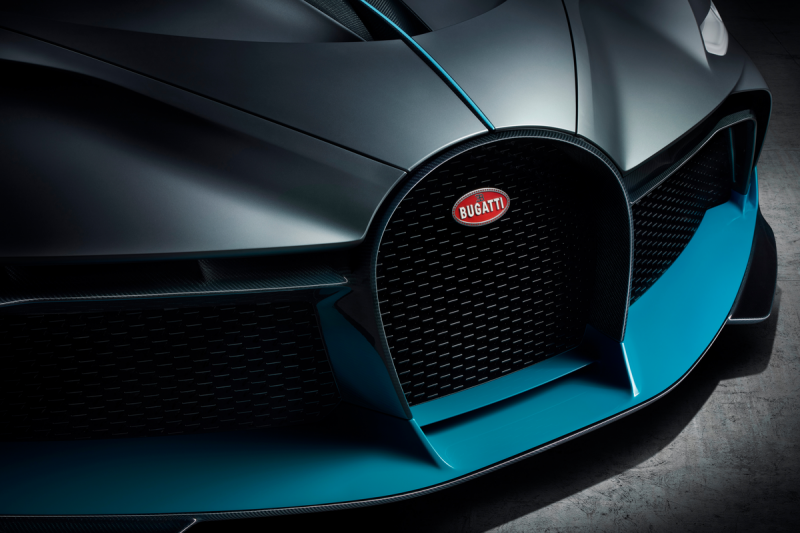
Bugatti enthüllte sein neuestes Modell auf der exklusiven Veranstaltung „The Quail – A Motorsports Gathering“ in Kalifornien
• Bugatti-Präsident Stephan Winkelmann: „Der Divo ist deutlich performanter in Sachen Querbeschleunigung, Agilität und Kurvenverhalten. Der Divo ist gemacht für Kurven.“
• Ausgefeiltes Aerodynamik-Programm, Modifikationen an Fahrwerk und Dämpfung sowie Gewichtsreduzierung machen den Divo zum Kurvenstar 35 kg leichter als der Chiron.
• Höhere Querbeschleunigung von 1,6 g • 90 kg mehr Abtrieb als der Chiron
• Höchstgeschwindigkeit bei 380 km/h abgeregelt
• 8 Sekunden schnellere Rundenzeit auf dem Handlingkurs in Nardó
• Neue progressive Formsprache unterstreicht die inneren Werte des Divo
• Divo ist die moderne Interpretation der Bugatti-Coachbuilding-Tradition
• Divo wird als Straßenfahrzeug homologiert
• Streng limitierte Kleinstserie von 40 Fahrzeugen ist bereits ausverkauft
•Netto-Stückpreis: 5 Millionen Euro
Mit dem Divo hat die französische Luxusmarke einen Supersportwagen entwickelt, der auf Agilität, Wendigkeit und optimale Handling-Performance auf kurvenreichen Straßen getrimmt ist. Er wird vom ikonischen 1.500 PS starken 8-LiterW16-Motor Bugattis angetrieben. Intensivst wurde an den aerodynamischen Eigenschaften gearbeitet sowie Fahrwerkeinstellungen verändert. Im Ergebnis ist der Divo, verglichen mit dem Serienmodell Chiron2 , 35 Kilogramm leichter und hat 90 Kilogramm mehr Abtrieb. Bei der Querbeschleunigung hat der Divo auf 1,6 g zugelegt. Seine Höchstgeschwindigkeit ist auf 380 km/h limitiert. Den Handlingkurs auf dem Testund Prüfgelände von Nardò in Süditalien umrundet der Divo acht Sekunden schneller. Nur 40 Fahrzeuge wird es geben. Die streng limitierte Kleinstserie war bei Start der Präsentationen vor ausgewählten Kunden bei einem Nettostückpreis von 5 Millionen Euro sofort ausverkauft. „Als ich Anfang dieses Jahres mein Amt bei Bugatti antrat, lernte ich schnell, dass unsere Kunden und Fans auf ein spezielles Fahrzeug warten, das parallel zum Chiron eine weitere Geschichte für die Marke erzählt“, sagte Stephan Winkelmann, Präsident von Bugatti Automobiles S.A.S. „Auch das Bugatti-Team brannte darauf, solch ein Projekt umzusetzen.“ So wurde entschieden, einen Supersportwagen zu bauen, der einen anderen Charakter haben soll als der Chiron, aber dennoch auf den ersten Blick als ein Bugatti erkennbar bleibt. Mit dem Divo lässt Bugatti seine Tradition im Karosseriebau, Coachbuilding genannt, wieder aufleben. Die französische Luxusmarke hatte in den frühen Jahrzehnten ihres Bestehens großen Erfolg darin, Karosserien nach eigenem Design selbst zu bauen und auf bestehende Chassis zu setzen. „Während ein moderner Bugatti bislang für die perfekte Balance von HochleistungsPerformance, Längsdynamik und luxuriösem Komfort steht, sollte der Divo im Rahmen der Möglichkeiten deutlich performanter in Sachen Querbeschleunigung, Agilität und Kurvenverhalten gehen“, so Winkelmann weiter. „Der Divo ist gemacht für Kurven.“ „Das Feedback unserer Kunden war überwältigend“, erklärt der Bugatti-Präsident. „Wir haben den Divo einer kleinen Gruppe ausgewählter Chiron-Kunden gezeigt. Alle 40 Fahrzeuge waren sofort verkauft – eine tolle Bestätigung für das Bugatti-Team, das mit viel Herzblut und Leidenschaft gearbeitet hat.“ „Der Divo ist ein weiteres Projekt, mit dem wir die Menschen und die Welt begeistern wollen“, fügt Winkelmann an. „Denn unsere Fans sind uns sehr wichtig.“ Benannt ist der Bolide nach Albert Divo, französischer Rennfahrer, der in den späten 1920er Jahren für Bugatti zweimal das berühmte Bergstraßenrennen Targa Florio auf Sizilien gewann.

Der Divo steht für die moderne Interpretation der Coachbuilding-Tradition der Marke „Die moderne Interpretation des Coachbuilding hat uns Ingenieuren neue Freiheiten gegeben“, so Stefan Ellrott, Leiter der Technischen Entwicklung bei Bugatti. „Der Schritt, den wir mit dem Divo in Sachen Agilität und performanter Kurvendynamik erreicht haben, kann mit der Entwicklung verglichen werden, die wir vom Veyron hin zum Chiron insgesamt vollzogen haben.“ Ausgefeiltes Aerodynamik-Programm sorgt für optimale Fahrzeugkühlung und 90 Kilogramm mehr Abtrieb Besonders an den aerodynamischen Eigenschaften des Divo wurde detailliert gearbeitet. Die Frontklappe ist mit Lufteinlässen versehen. Dies sorgt für eine Reduzierung der effektiven Stirnfläche des Fahrzeuges und einen verbesserten Luftfluss an der Fahrzeugfront sowie eine Erhöhung der aerodynamischen Effizienz. Darüber hinaus sorgt ein optimierter sogenannter Air Curtain für eine bessere Luftführung im vorderen und hinteren Bereich der Fahrzeugseiten. Der breite und neu geformte Frontspoiler dient einem höheren Abtrieb und leitet mehr Luft zu den vorderen Lufteinlässen. Damit erhält das Kühlsystem mehr Luftmasse, und die Kühlleistung insgesamt wird gesteigert. Die Bremsen werden aus vier unabhängigen Luftquellen an jeder Fahrzeugseite gekühlt: So kommt Luft aus dem Hochdruckbereich oberhalb des Frontstoßfängers, aus den Einlässen auf den vorderen Kotflügeln, vom Einlass am vorderen Radiator und aus den Diffusoren vor den Reifen. Schaufeln führen die kalte Luft aus diesen Bereichen in die Bremsscheiben. Ein sogenanntes Hitzeschild leitet die dann heiße Luft direkt durch die Räder nach außen. So wird erreicht, dass die Bremsen sich nicht überhitzen und die Reifentemperatur stets im optimalen Bereich bleibt. Dieses bereits beim Chiron angewandte System erhält beim Divo zusätzliche Unterstützung durch den Unterdruck, der durch den Air Curtain an den Reifen erzeugt wird. Außerdem werden die Radkästen durch Lamellen auf den Kotflügeln entlüftet. Das Dach des Divo wurde in Form eines NACA Air-Duct, das ist ein strömungsgünstiger Lufteinlass, gestaltet. In Kombination mit dem Heckdeckel in einem speziell entwickelten Design kann so ein sehr hoher Luftmassenfluss in den Motorraum erreicht und damit ein wichtiger Beitrag zum Temperaturmanagement in diesem Bereich des Fahrzeugs geleistet werden. Am Heck des Divo ragt ein neuer, in der Höhe feststehender Heckflügel empor, der weiterhin, nach vorne aufgestellt, als Air Brake fungiert sowie für die individuellen Fahrzeugmodi winkelverstellbar bleibt. Der Heckflügel misst 1,83 Meter (72”) und ist damit 23 Prozent breiter als der des Chiron. Die größere Flügelfläche dient der Effizienzsteigerung und resultiert in einer leistungsfähigeren Air Brake sowie deutlich mehr Abtrieb. Dieser wird weiter verstärkt durch den Heckdiffusor, der komplett neu sowie effizienter gestaltet wurde und die vier Abgasrohre beherbergt. Insgesamt wird dadurch ein Abtrieb von 456 Kilogramm erreicht, das sind 90 kg mehr als beim Chiron.

Neue Einstellungen an Fahrwerk und Dämpfung sowie Gewichtsreduzierung machen den Divo zum Kurvenstar Die Fahrwerkentwicklung stand ganz im Zeichen der Kurvendynamik. Spritziger, agiler und leichtfüßiger sollte der Divo werden. Dafür wurde der Radsturz erhöht, was in der Folge dazu führte, dass die Höchstgeschwindigkeit des Divo auf 380 km/h limitiert ist. Es gibt also, anders als beim Chiron, keinen Top Speed Modus. Bei der Querbeschleunigung hat der Divo auf 1,6 g zugelegt. Schon allein diese Maßnahmen erlauben ein spürbar neues Fahrgefühl auf kurvigen Strecken. Die Einstellungen von Lenkung und Dämpfung wurden so vorgenommen, dass das Fahrzeug noch direkter anspricht und ein deutlich sportliches Fahrverhalten in allen Fahrmodi (EB, Autobahn und Handling) erkennbar sein wird. Der Divo ist 35 Kilogramm leichter als der Chiron. Die Gewichtsreduzierung ist auf eine Reihe von Leichtbaumaßnahmen zurückzuführen, darunter neue Leichtbau-Räder und eine Ladeluftkühler-Abdeckung aus Kohlefaser. Darüber hinaus konnte durch die Fixierung der vorderen Diffusorklappen, den Entfall von Dämmmaterialien und den Einbau eines leichteren Soundsystems Gewicht eingespart werden. Zudem wurde im Sinne des Leichtbaus an Mittelkonsole und Türverkleidungen auf Ablagefächer verzichtet. Somit wird der Divo acht Sekunden schneller auf dem Handling-Kurs von Nardo unterwegs sein als der Chiron. Neue progressive Formsprache unterstreicht die inneren Werte des Divo: Ein neuer Anzug für einen neuen Charakter „Der Divo ist ein weiteres Beispiel unserer Design-Philosophie ‚Form follows Performance‘. In diesem Fall ging es den technischen Entwicklern und den Designern darum, gemeinsam ein Fahrzeug zu kreieren, dessen Fokus auf Kurvengeschwindigkeit und Querdynamik liegt“, beschreibt Achim Anscheidt, Designchef Bugatti Automobiles S.A.S., die Formsprache des neuen Bugatti. „Gleichzeitig war das Projekt Divo eine willkommene Gelegenheit für unser Team, dem in den frühen Jahren der Marke sehr erfolgreichen Thema Coachbuilding nun ein neues, modernes Kapitel hinzuzufügen.“ „Unsere Aufgabe war es, ein Fahrzeug zu entwickeln, das anders als der Chiron aussehen, dabei aber auf den ersten Blick als ein Bugatti erkennbar sein sollte“, so Anscheidt weiter. „Das bedeutete für uns Designer, dass die drei wichtigsten stilistischen Elemente Bugattis erhalten bleiben mussten: das Hufeisen am Front-Grill, die typische Bugatti-Signatur-Linie an den Fahrzeugseiten sowie die vom Typ 57 Atlantic hergeleitete charakteristische Finne, die die Längsachse des Fahrzeugs in der Ansicht von oben bestimmt.“ Das Design-Team hat diese Merkmale für den Divo entsprechend der Entwicklungsvorgabe weiterentwickelt und die Design-Philosophie „Form follows Performance“ neu interpretiert. Die Außenhülle des Divo wurde kompromisslos auf Querbeschleunigung ausgelegt. Dabei ging es in erster Linie darum, eine optimale aero- und thermodynamische Effizienz zu erzielen.

Gleichzeitig repräsentiert der Divo einen neuen stilistischen Ansatz, den das Designteam eigens für einen „Coachbuilt“-Bugatti entwickelt hat und der sich von den modernen Kernprodukten der Marke unterscheidet. Die schlankere Seitenlinie des Divo trägt dazu bei, das Fahrzeug tiefer und länger aussehen zu lassen. Die neuen Proportionen ermöglichten eine visuelle horizontale Teilung des Körpers, die durch eine spezielle Farbgebung noch verstärkt wird. Der obere eleganter wirkende Teil ist in dem für den Divo entwickelten Silberton „Titanium Liquid Silver“ matt lackiert, der die skulpturalen und muskulösen Formen wirkungsvoll in Szene setzt. Die langen, gewölbten und in der Oberfläche ungestörten Flächen entlang der C-Säule und der hinteren Seitenteile verleihen der Fahrerkabine einen visuellen Schub nach vorn. Dies verleiht dem Divo bereits im Stillstand einen extrem dynamischen Auftritt. Der untere Teil der Fahrzeugseiten wurde mit seinen Formen technischer gestaltet, was dem Fahrzeug optisch Kraft und einen selbstbewussten Stand auf der Fahrbahn verleiht. Dieser Bereich ist in Sicht-Carbon gehalten, in einer für den Divo exklusiv entwickelten petrol-blauen Tintung, „Divo Carbon“ genannt. Für die Fahrzeug-Front wurde eine komplett neue Architektur entwickelt. Es gibt zusätzliche Lufteinlässe zur Bremsenkühlung. Die neuen vertikal ausgerichteten Frontleuchten mit dem Tagfahrlicht am jeweils äußeren Rand verleihen dem Divo eine optische Weite. Die extrem kompakten und leichten LED-Scheinwerfer erreichen mit ihrer gerade einmal 35 Millimeter (1 3/8“) flachen Leuchtenöffnung eine neue technische Dimension. Eine eigens für den Divo entwickelte Lichtanimation unterstreicht die unverwechselbare Signatur der Frontpartie. Ihre horizontale Teilung in einen unteren Bereich aus Sicht-Carbon und den in mattem Silber lackierten oberen Bereich lassen den Divo zudem flacher wirken und unterstreichen den Eindruck der optischen Breite. Der NACA-Lufteinlass auf dem Fahrzeugdach schafft eine optische Verbindung zum Luftauslass in der Mitte der Fronthaube und leitet die Luft in Richtung des Heckflügels. Die Tatsache, dass die Mittelfinne von der Fahrzeugfront über das Dach bis zum Heckflügel verläuft, ist nicht nur eine Erinnerung an Bugattis legendäre Vergangenheit, sondern erfüllt auch eine Funktion: Damit wird verhindert, dass die Luft über dem Fahrzeug verwirbelt und Turbulenzen am Heckflügel entwickelt. Ein Highlight am Fahrzeugheck ist zweifellos die neue hochkomplexe 3D-Heckleuchte. Sie ist tatsächlich Teil des Heckgitters, das teilweise im 3D-Druckverfahren produziert wird und über spezielle leichte Finnen in verschiedenen Größen verfügt. Insgesamt 44 dieser Finnen leuchten und bilden so das Hecklicht des Divo. Am äußeren Rand sind die Finnen breiter, das erzeugt ein intensiveres Licht. Zur Fahrzeugmitte hin werden die Finnen jeweils schmaler und das Licht dadurch graduell schwächer. Das Ergebnis ist eine auffällige Optik, die den Divo auch von hinten unverwechselbar macht. Ebenfalls am Heck verstärkt die Farbzweiteilung des Fahrzeugs den kraftvollen Eindruck: Die Kotflügel sind in „Titanium Liquid Silver“ matt lackiert und werden optisch von den Teilen getrennt, die den Luftfluss am Heck steuern. So sind Luftauslässe, Heckflügel und Diffusor in Sicht-Carbon gehalten.

Die speziell für den Divo entworfene leuchtende türkisblaue Farbe „Divo Racing Blue“ unterstreicht die Dreidimensionalität der drei Oberflächen, die vorne, an der Seite und hinten zu den jeweils dort befindlichen Luftein- und auslässen führen, und schafft dynamisch wirkende Kontraste. Das technisch anmutende Farb- und Materialkonzept des Exterieurs zieht sich auch durch das Interieur. Hier kommt das hochglänzende exklusive Sicht-Carbon des Exterieurs in einer matten Ausführung zum Einsatz. Sowohl die Carbon-Tintung als auch die Lackierung der Außenhaut werden in ihrer Farbwirkung 1:1 vom dunklen Alcantara-Petrol-Ton „Divo Grey“ im Innenraum abgebildet und stehen in einem subtil technischen Kontrast zu den glasgestrahlten grau-eloxierten Metallteilen des Interieurs.

Das markante „Divo Racing Blue“ kommt auch im Interieur als Alcantara-Leder-Ton zum Einsatz und spielt hier eine spezielle Rolle, indem es den Innenraum des Divo zweiteilt. Der Fahrerbereich ist fast komplett in dieser markanten Farbe gehalten, während sie im dunkleren Beifahrerbereich für ausgewählte Akzente sorgt. Eine weitere stilistische Verbindung zum Exterieur schaffen Türverkleidung und Sitzflächen, die mit einer gestickten, dreidimensional und algorithmisch angeordneten Rautenstruktur verziert sind und damit die Gitter- und Heckleuchtenarchitektur neu interpretieren. Technische Neuerungen im Innenraum betreffen die Sitze, die neben dem neuen Design mehr Seitenhalt bieten. Das Lenkrad ist teilweise mit Alcantara bezogen und verfügt über größere lenkradfeste Wippschalter auf beiden Seiten. Die Mittelkonsole schafft dank größerer Armauflagen und Wadenanlagen mehr Komfort.

Französischer Rennfahrer und zweifacher Targa Florio-Sieger Albert Divo als Namenspate Albert Divo wurde am 24. Januar 1895 unter dem Namen Albert Eugène Diwo (er nannte sich später selbst Divo) in Paris geboren. Im Ersten Weltkrieg war er Kampfpilot, danach arbeitete er als Mechaniker. Seine Karriere als Automobilrennfahrer begann 1919 für Sunbeam und für Talbot-Darracq, wo er schnell erfolgreich war und 1923 in Sitges den Großen Preis von Spanien gewann. 1924 wechselte er zu Delage. Hier startete er unter anderem in einer Reihe von Sprintrennen in Frankreich. Nach einem aufgrund nicht ausgereifter Technik weniger erfolgreichen Aufenthalt bei Talbot von 1926 bis 1927 kehrte er zu Delage zurück, wurde dort aber nicht eingesetzt. Als Talbot und Delage sich aus dem Rennzirkus verabschiedeten, trat Divo 1928 dem Werksteam von Bugatti bei. Auf Anhieb gewann er im selben Jahr auf einem Typ 35 B die Targa Florio in Sizilien. Diesen Triumph wiederholte er im darauf folgenden Jahr. 1930 wurde er Dritter in Spa. Es folgten weitere Renneinsätze für Bugatti bis 1933 auf den Typen 51, 53, 54 sowie auf den Typen 45 und 47 bei Bergrennen. Ab 1936 startete er abwechselnd für Delahaye und Talbot. Im Jahr 1939 beendete er seine aktive Karriere.

Nach dem Zweiten Weltkrieg arbeitete Albert Divo als Rennleiter bei Castrol. 1962 war er in Villarssur-Ollon (Schweiz) Gründungsmitglied des Club International des Anciens Pilotes de Grand Prix F1. Divo wurde als Ritter der Ehrenlegion ausgezeichnet. Am 19. November 1966 starb er zurückgezogen in Morsang-sur-Orge südlich von Paris. Divo feierte seine größten Erfolge zweifellos bei der Marke Bugatti, deren Dominanz 1925 auf der Targa Florio begann. Die legendäre Targa Florio, die bis 1977 jährlich auf einer Bergstrecke in Sizilien ausgetragen wurde, war sicherlich eines der härtesten aller Langstreckenrennen in dieser Zeit. Bugatti gewann das Rennen mit dem Typ 35 fünfmal in Folge. Bugatti Coachbuilding: Karosserien ab Werk „Made in Molsheim“ Mit dem Divo lässt Bugatti seine Karosseriebau-Tradition wieder aufleben. Während Ettore Bugattis Fahrzeuge der 1920er Jahre für Leichtbau und technische Innovationen standen, so war es das Verdienst seines Sohnes Jean, dass die Bugatti-Karosserien in den 1930er Jahren zu den stilbildenden ihrer Zeit wurden. Die Kreationen von Jean stehen bis heute sinnbildlich für die goldene Ära des französischen Karosseriebaus, und so trugen Vater und Sohn jeweils auf ihre ganz eigene Art zum Mythos der Marke bei. Mitte der 1920er Jahre bezog Ettore Bugatti seinen Sohn zunehmend mehr in die Firma ein, und so war es Jean, der erst für den Typ 41 Royale und ab 1926 auch für den Typ 40 Ideen eigener Karosserieformen entwickelte. Bis dato wurden zwei- und viersitzige Sport-Cabriolets und -Coupés von Karosseriebauern wie Gangloff oder Lavocat & Marsaud gefertigt. Zur Umsetzung seiner Ideen holte Jean den talentierten Karossier Joseph Walter nach Molsheim. Erst mit Walter, der Jeans Ideen gestalterisch umsetzte, konnte der klassische Karosseriebau bei Bugatti richtig angegangen werden: mit den Grand Sport-Karosserien der Typen 40 und 43 bis hin zu den Typ 57-Karosserien der 1930er Jahre. Für den Typ 57 waren ab Werk unterschiedliche Karosserien wie Stelvio, Aravis, Galibier, Ventoux oder Atalante bestellbar. Die bekanntesten „Coachbuilt“-Kreationen aus dem Hause Bugatti waren zweifellos der stromlinienförmige Typs 50, der Typ 55 Roadster oder der Typ 57SC Atlantic.
Seriennahes Fahrzeug – unterliegt nicht der Richtlinie 1999/94/EG, da Gesamtbetriebserlaubnis derzeit noch nicht vorliegt 2 Kraftstoffverbrauch, l/100km: innerorts 35,2 / außerorts 15,2 / kombiniert 22,5; CO2-Emission kombiniert, g/km: 516; Effizienzklasse: G
La Divo est faite pour avaler les virages.
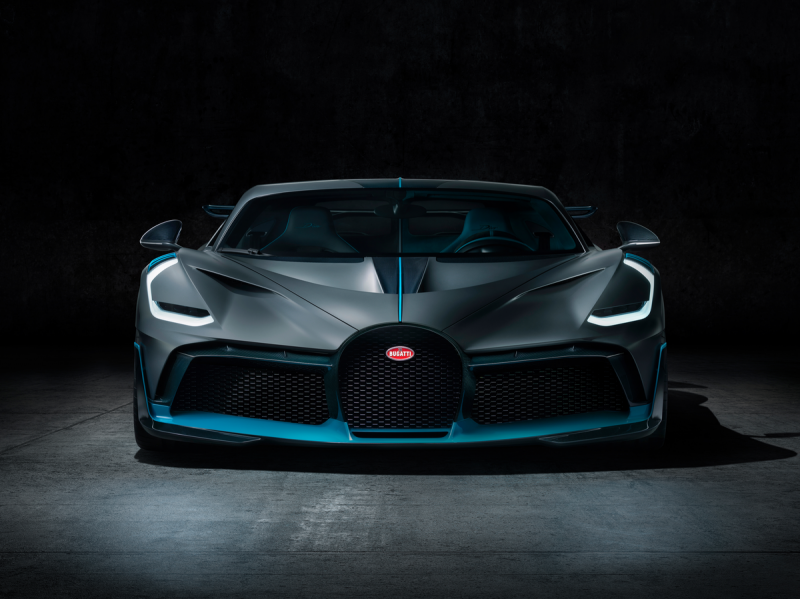
Première mondiale pour la Divo : Bugatti dévoile son dernier modèle à l’occasion du célèbre rassemblement californien de voitures de sport « The Quail – A Motorsports Gathering »
• Stephan Winkelmann, Président de Bugatti : « La Divo affiche des performances exceptionnelles en matière d’accélération latérale, de maniabilité et de comportement en courbe. La Divo est faite pour avaler les virages. » Perfectionnement de l’aérodynamique, optimisation du châssis et de l’amortissement, réduction du poids : la Divo réunit tous les ingrédients pour négocier les courbes avec brio.
• 35 kg en moins par rapport à la Chiron Accélération latérale portée à 1,6 g
• Déportance accrue de 90 kg par rapport à la Chiron
• Vitesse de pointe bridée à 380 km/h
•8 secondes plus rapide que la Chiron sur le circuit d’essai de maniabilité de Nardó
• Des qualités intrinsèques soulignées par un langage stylistique inédit au caractère novateur.
• La Divo est une déclinaison moderne de l’expertise Bugatti en matière de conception de carrosserie automobile qui s’inscrit pleinement dans la tradition du constructeur.
• La Divo sera homologuée pour circuler sur la route.
• Les 40 exemplaires de la série très limitée sont déjà vendus.
• Prix de vente net : 5 millions d’euros.

Avec la Divo, le constructeur automobile de luxe français a développé une supersportive qui se distingue par sa maniabilité, sa vivacité en courbe et ses remarquables performances dynamiques sur les tracés sinueux. Elle est équipée du mythique moteur Bugatti W16 de 8 litres de cylindrée et 1 500 ch de puissance. Les propriétés aérodynamiques et les réglages du châssis ont été optimisés. Résultat : la Divo affiche 35 kg en moins sur la balance par rapport au modèle de série Chiron2 , et une déportance accrue de 90 kg. L’accélération latérale est portée à 1,6 g. La vitesse de pointe a été limitée à 380 km/h. Elle réalise le tour du circuit d’essai de maniabilité de Nardò, dans le sud de l’Italie, en 8 secondes de moins que la Chiron. Elle sera produite à 40 exemplaires. La très petite série a été entièrement vendue dès la présentation du nouveau modèle à une sélection de clients. Son prix de vente net est de 5 millions d’euros. « Quand j’ai pris mes fonctions chez Bugatti en début d’année, j’ai su rapidement que les clients et les passionnés de la marque attendaient un modèle spécial qui, parallèlement à la Chiron, ouvrirait un nouveau chapitre dans l’histoire de l’entreprise », a déclaré Stephan Winkelmann, Président de Bugatti Automobiles S.A.S. « L’équipe Bugatti s’est donc attelée à la tâche pour mener à bien ce projet. » Il fut alors décidé de construire une supersportive dotée d’un caractère certes différent de la Chiron, mais dont la filiation Bugatti serait identifiable au premier coup d’œil. La Bugatti Divo s’inscrit pleinement dans la tradition du constructeur en matière de conception de carrosserie automobile. Dans les premières décennies de son existence, la marque de luxe française a rencontré un grand succès en construisant des carrosseries montées sur des châssis existants. « Une Bugatti moderne allie à la perfection puissance, capacité d’accélération, confort et luxe. Il s’agissait pour la Divo d’offrir des performances accrues en matière d’accélération latérale, de maniabilité et de comportement en courbe », souligne Stephan Winkelmann. « La Divo est faite pour avaler les virages. » « La voiture a reçu un formidable accueil auprès de nos clients », poursuit le Président de Bugatti. « Nous avons présenté la Divo à un petit groupe de clients, déjà propriétaires d’une Chiron. Les 40 véhicules ont été vendus immédiatement, ce qui constitue une formidable reconnaissance pour l’équipe Bugatti qui a travaillé avec passion et détermination à la réalisation de ce modèle d’exception. » « Avec la Divo, nous voulons enthousiasmer les passionnés du monde entier », conclut Stephan Winkelmann. « Les amateurs de la marque sont toujours au cœur de toute notre attention. » Ce nouveau modèle doit son nom au pilote français Albert Divo, qui remporta, à la fin des années 1920, deux victoires au volant d’une Bugatti sur le tracé sinueux de la Targa Florio, la célèbre course d’endurance sicilienne.

La Divo est une déclinaison moderne de l’expertise Bugatti en matière de conception de carrosserie automobile qui s’inscrit pleinement dans la tradition du constructeur. « L’interprétation moderne de l’art de la carrosserie a ouvert de nouveaux espaces de liberté à nos ingénieurs », précise Stefan Ellrott, Directeur du développement technique chez Bugatti. « L’étape que nous avons franchie avec la Divo en matière de maniabilité et de dynamique de conduite en courbe est comparable à celle que nous avions franchie lorsque nous sommes passés de la Veyron à la Chiron. » Une aérodynamique optimisée pour un meilleur refroidissement et une déportance accrue de 90 kg Les propriétés aérodynamiques de la Divo ont été travaillées jusque dans le moindre détail. Le capot avant a été doté d’entrées d’air afin d’en réduire la surface de frottement et d’optimiser les flux d’air à l’avant de la voiture pour une grande efficacité aérodynamique. En outre, un rideau d’air optimisé (Air Curtain) assure un meilleur écoulement de l’air sur les flancs de la voiture, à l’avant comme à l’arrière.

Le nouveau spoiler avant, aux dimensions généreuses, assure une déportance accrue et permet de diriger l’air vers les entrées avant. Ainsi, le système de refroidissement est alimenté par une masse d’air plus importante, ce qui se traduit par un meilleur refroidissement de la voiture dans son ensemble. Les freins sont refroidis par quatre sources d’air distinctes disposées de chaque côté de la voiture. L’air pénètre par la zone à haute pression créée au-dessus du parechoc avant, par les entrées disposées sur les ailes avant, par l’entrée d’air du radiateur avant et par les diffuseurs situés devant les passages de roue. L’air froid est ensuite dirigé par des aubes vers les disques de frein.

L’air chaud est ensuite dissipé vers l’extérieur par le passage de roue via un écran thermique. Ce dispositif de refroidissement permet d’éviter la surchauffe des freins et de maintenir les pneumatiques à température optimale. Déjà utilisé sur la Chiron, le système de dissipation par écran thermique bénéficie d’une efficacité accrue sur la Divo en raison de la dépression générée par le rideau d’air (Air Curtain) au niveau des roues. Par ailleurs, les passages de roue sont ventilés par des ouïes à lamelles sur les ailes.

Le profil aérodynamique NACA du toit optimise la pénétration dans l’air de la voiture. Cette ligne de toit, associée au capot arrière dans son design entièrement nouveau, permet d’acheminer un important flux d’air dans le compartiment moteur, contribuant ainsi de manière décisive à la régulation thermique du groupe motopropulseur. La Divo est dotée d’un nouvel aileron intégré à l’arrière. Son angle d’inclinaison varie en fonction du mode de conduite sélectionné, et lorsqu’il est entièrement déployé vers l’avant, il fait office d’aérofrein (Air Brake). L’aileron arrière mesure 1,83 mètre (72”), soit un gain en largeur de 23 % par rapport à celui de la Chiron. Il offre une plus grande surface de frottement, ce qui se traduit par une efficience aérodynamique supérieure, une meilleure performance de la fonction aérofrein (Air Brake) et une déportance accrue.
La forme suit la performance

L’effet aérodynamique de l’aileron est renforcé par un diffuseur arrière qui a été entièrement reconfiguré pour gagner en efficacité et dans lequel sont logées les quatre sorties d’échappement. Au total, la déportance atteint 456 kg, soit 90 kg de plus que sur la Chiron. Nouveaux réglages du châssis, amortissement optimisé et réduction du poids : la Divo s’impose avec brio dans les courbes. Le châssis est essentiel à la dynamique de conduite en courbe. Vivacité, agilité et maniabilité : telles sont les qualités qui figuraient au cahier des charges de la Divo. Pour répondre à ces impératifs, il a fallu augmenter le carrossage, ce qui a eu pour conséquence de limiter la vitesse de pointe de la Divo à 380 km/h. Contrairement à la Chiron, la Divo n’est pas dotée d’un mode Top Speed. L’accélération latérale a quant à elle été portée à 1,6 g. Ces caractéristiques suffisent à procurer un plaisir de conduite unique sur les tracés sinueux. La direction et les amortisseurs ont été réglés de manière à bénéficier d’une réponse plus directe et d’un comportement dynamique nettement plus sportif dans tous les modes de conduite (EB, Autoroute et Handling). La Divo est plus légère de 35 kg par rapport à la Chiron. Cette réduction du poids s’explique par un large recours à des matériaux allégés. Ainsi, les nouvelles jantes sont réalisées en alliage léger et le carter du refroidisseur d’air de suralimentation est en fibre de carbone. En outre, l’optimisation en poids du système de fixation des volets du diffuseur avant, la suppression de certains matériaux isolants et l’intégration d’un système audio plus léger contribuent à l’allègement de la voiture. En outre, l’absence de rangements sur la console centrale et dans les portières répond également à cet impératif de diminution du poids. Ainsi, la Divo boucle le circuit d’essai de maniabilité de Nardó en huit secondes de moins que la Chiron. Nouveau caractère, nouveau costume : le langage stylistique novateur de la Divo souligne les qualités intrinsèques de la voiture. « La Divo illustre une fois encore le principe directeur de Bugatti en matière de design : « Form follows Performance » (La forme suit la performance). Il s’agissait ainsi pour les développeurs et les concepteurs de la marque de créer ensemble une voiture mettant l’accent sur la vitesse en courbe et la dynamique latérale ». C’est ainsi que Achim Anscheidt, Directeur du design de Bugatti Automobiles S.A.S., décrit les principes qui ont prévalu à la conception de la nouvelle Bugatti. « Parallèlement, le projet Divo a constitué une formidable opportunité qui a permis à l’équipe de designers de renouer avec le cœur de métier de l’entreprise et d’écrire un nouveau chapitre en matière de conception de carrosserie. »

« Il s’agissait de développer une voiture certes différente de la Chiron, mais dont la filiation Bugatti serait identifiable au premier coup d’œil », poursuit Achim Anscheidt. « Les concepteurs se sont donc attachés à préserver les trois principaux éléments qui constituent la signature stylistique de Bugatti : la calandre en fer à cheval, la ligne de flanc typique Bugatti et la ligne de crête héritée de la Bugatti Type 57 Atlantic, qui trace une arête dorsale tout au long de l’axe longitudinale de la voiture. » L’équipe de designers s’est attachée à perfectionner les caractéristiques stylistiques de la marque en suivant le cahier des charges défini pour le développement de la Divo et a livré une nouvelle interprétation du principe de design « Form follows Performance ». La conception de la caisse de la Divo n’a souffert d’aucun compromis afin d’offrir à la voiture une accélération latérale optimale. Les concepteurs se sont avant tout attachés à optimiser l’efficience aérodynamique et thermodynamique. Par ailleurs, les designers de la marque ont adopté une approche stylistique novatrice pour concevoir une carrosserie à la Bugatti. C’est ainsi que la Divo se distingue des autres produits phare proposés par la marque aujourd’hui. Avec ses flancs effilés, la Divo a une silhouette plus ramassée, mais aussi des lignes plus allongées. Les nouvelles proportions de la caisse créent visuellement une séparation horizontale, avec une ligne de partage soulignée par les différentes teintes de carrosserie. La partie supérieure, particulièrement élégante, arbore une teinte argent mat, créée spécialement pour la Divo et baptisée « Titanium Liquid Silver » (vif-argent titane). Cette teinte met en valeur les formes sculpturales et athlétiques de la voiture. Les surfaces effilées et galbées qui courent le long du montant arrière ainsi que les éléments de carrosserie à l’arrière de la voiture semblent, sur le plan visuel, avoir propulsé le cockpit vers l’avant. Dès lors, même à l’arrêt, la Divo dégage une formidable impression de dynamique. Sur les flancs, la partie inférieure répond sur la forme à des impératifs techniques. La voiture dégage une impression visuelle de puissance et affiche un caractère affirmé sur la route. La partie inférieure en carbone apparent arbore une nuance bleu pétrole exclusive, baptisée « Divo Carbon ». L’architecture avant de la Divo a été entièrement repensée. Des entrées d’air supplémentaires ont été aménagées pour assurer le refroidissement des freins. À l’avant, la signature visuelle de la Divo tient à la disposition verticale de ses nouveaux optiques de phare, avec les feux de jour agencés sur le bord extérieur.

Les phares à LED, extrêmement compacts et légers, avec leur ouverture lumineuse de 35 mm (1 3/8“), donnent une nouvelle dimension technique à l’éclairage automobile. Une animation lumineuse spécifique à la Divo renforce la signature visuelle à l’avant de la voiture. La ligne de partage horizontale, avec la partie inférieure en carbone apparent et la partie supérieure en argent mat, aplanit visuellement les lignes de la Divo et accentue l’impression de largeur. L’entrée d’air au profil aérodynamique NACA sur le toit de la voiture se prolonge visuellement jusqu’à la sortie d’air au milieu du capot avant et conduit l’air vers l’aileron arrière. La crête qui court de l’avant de la voiture jusqu’à l’aileron arrière, en passant par le toit, est certes un hommage appuyé aux modèles emblématiques de la marque, mais elle a aussi une fonction : elle fait aussi office de dérive aérodynamique pour éviter le tourbillonnement des flux d’air audessus de la voiture et la formation de turbulences au niveau de l’aileron arrière.

L’arrière de la voiture se distingue principalement par ses nouveaux blocs optiques en relief. Les optiques sont intégrés à la calandre arrière, fabriquée en partie par procédé d’impression 3D. La grille est finement striée de rais de lumière de différentes tailles. Au total, 44 stries s’illuminent pour constituer l’éclairage arrière de la Divo. Sur le bord extérieur, les rais de lumière s’élargissent, ce qui intensifie la luminosité. Vers le milieu, les rais sont en revanche plus étroits, ce qui atténue progressivement la luminosité. Il en résulte un éclairage unique, qui signe incontestablement l’arrière de la Divo. À l’arrière, la livrée bicolore de la voiture accentue l’impression de puissance : les ailes sont en argent mat « Titanium Liquid Silver » (vif-argent titane) et se distinguent visuellement des éléments assurant le guidage du flux d’air à l’arrière. Ainsi, les sorties d’air, l’aileron arrière et le diffuseur sont en carbone apparent. La teinte éclatante en turquoise spécialement créée pour la Divo, baptisée « Divo Racing Blue », souligne la conception tridimensionnelle de la caisse, avec des éléments à l’avant, sur les flancs et à l’arrière qui acheminent l’air, en entrée ou en sortie, et crée un contraste dynamique saisissant. Les pneumatiques attirent également le regard avec leur couleur « Divo Racing Blue ». La Divo est la première Bugatti dont les pneumatiques sont ornés de bandes de couleur, un détail visuel issu de la course automobile. Les teintes et les matériaux choisis pour la carrosserie trouvent un prolongement dans l’habitacle. Le carbone apparent exclusif en finition haute brillance dont est parée la carrosserie se décline en version mate dans l’habitacle. Les nuances des éléments carbone et de la teinte de carrosserie se retrouvent parfaitement dans l’habitacle avec l’habillage gris sombre alcantara pétrole « Divo Grey » qui offre un contraste tout en élégance avec les inserts métalliques gris anodisé.

Le bleu « Divo Racing Blue » se décline dans l’habitacle avec les revêtements Alcantara et cuir qui habille les sièges et les éléments intérieurs. Cet habillage bicolore caractérise également l’intérieur de la Divo. Le bleu éclatant prédomine côté conducteur, tandis que le côté passager arbore un habillage plus sombre. L’habillage des panneaux de porte intérieurs et des sièges reprennent également les nuances de couleur de la carrosserie. Les sièges sont ornés de motifs en losange brodés en relief et disposés avec une grande précision. Ces motifs réinterprètent l’architecture de la grille et des feux arrière de la voiture. L’habitacle bénéficie de nouveautés sur le plan technique. Ainsi, les sièges, dans leur nouveau design, offrent un meilleur maintien latéral. Le volant est en partie revêtu d’Alcantara et comprend des palettes plus amples, fixées de part et d’autre. Avec ces accoudoirs plus grands et ses garnitures de protection des jambes, la console centrale offre un meilleur confort. De conception nouvelle, la lunette arrière en matériaux allégés de la Bugatti Divo permet, en fonction du réglage, d’apprécier pleinement la sonorité unique du 16 cylindres.
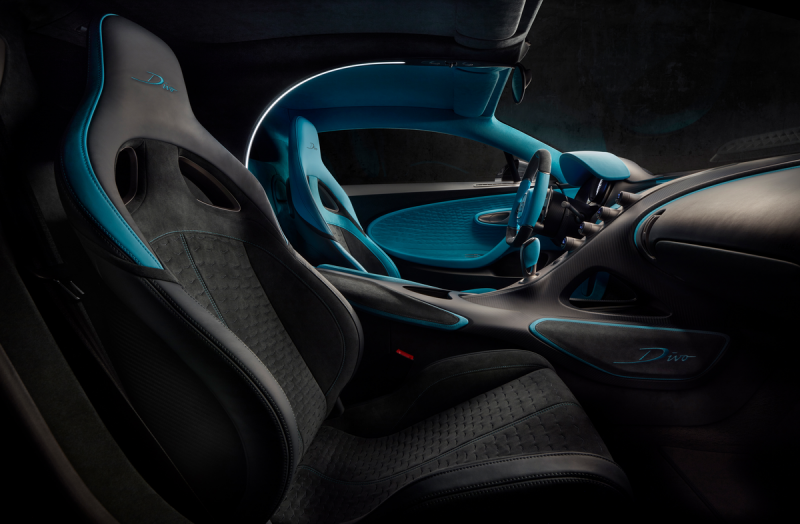
Le nom de la nouvelle Bugatti rend hommage au pilote français Albert Divo qui remporta à deux reprises la célèbre course Targa Florio au volant d’une Bugatti. Albert Divo est né à Paris le 24 janvier 1895 sous le nom d’Albert Eugène Diwo (il opte plus tard pour l’orthographe Divo). Pilote de combat lors de la Première Guerre mondiale, il travaille d’abord comme mécanicien. Sa carrière de pilote automobile commence en 1919. Il court alors sur Sunbeam puis sur Talbot-Darracq. Il remporte rapidement ses premiers succès, et en 1923, il gagne le Grand Prix d’Espagne à Sitges.

En 1924, il court pour l’écurie Delage. Il s’engage alors sur plusieurs courses de sprint en France. Après un court passage chez Talbot, de 1926 à 1927, au cours duquel le succès ne fut pas au rendez-vous pour des raisons techniques, il retourne chez Delage. Le pilote ne sera pas engagé en course. Lorsque Talbot et Delage se sont retirés de la compétition automobile, Divo rejoint l’équipe d’usine de Bugatti en 1928. Il remporte dès sa première année la Targa Florio en Sicile, au volant d’une Bugatti Type 35 B. Il renouvelle l’exploit l’année suivante. En 1930, il termine troisième à Spa. S’en suivront des participations à d’autres épreuves automobiles pour Bugatti jusqu’en 1933, sur des Bugatti Types 51, 53, 54, mais aussi sur des Bugatti Types 45 et 47 dans des courses de côte. À partir de 1936, il court alternativement pour Delahaye et Talbot. En 1939, il met un terme à sa carrière. Après la Seconde Guerre mondiale, Albert Divo travaille comme directeur de compétition pour la société Castrol. En 1962, il est l’un des membres fondateurs du Club International des Anciens Pilotes de Grand Prix F1, à Villars-sur-Ollon (Suisse). Albert Divo a été fait Chevalier de la Légion d’honneur. Le 19 novembre 1966, il s’éteint à Morsang-sur-Orge, au sud de Paris, dans la maison où il s’était retiré. Albert Divo a incontestablement connu ses plus grands succès avec la marque Bugatti, dont la domination sur la Targa Florio a commencé en 1925. La mythique course d’endurance sicilienne empruntait tous les ans, jusqu’en 1977, les routes du massif montagneux des Madonies. L’épreuve était considérée comme l’une des plus difficiles de la saison d’endurance à cette époque. Bugatti a gagné l’épreuve à cinq reprises d’affilée avec un modèle Type 35. Carrosserie Bugatti : un savoir-faire « Made in Molsheim » Avec la Divo, Bugatti perpétue la tradition de la marque dans l’art de la carrosserie automobile. Dans les années 1920, les voitures construites par Ettore Bugatti se distinguent déjà par leur légèreté et leurs innovations techniques. Jean Bugatti, son fils, travaille très tôt au bureau d’étude de l’usine où il dessine des carrosseries qui feront figure de référence sur le marché de l’automobile dans les années 1930. Aujourd’hui encore, les créations de Jean Bugatti constituent l’âge d’or de la carrosserie française. Ainsi, le père et le fils ont tous deux contribué à bâtir le mythe autour de la marque. Au milieu des années 1920, Ettore Bugatti implique toujours davantage son fils dans l’entreprise. C’est donc à Jean Bugatti que revient le soin de concevoir, selon ses propres idées, la Bugatti Type 41 Royale. À partir de 1926, il travaille également à la conception de la Bugatti Type 40. Jusqu’à cette date, des cabriolets et des coupés sport, deux et quatre places, sont également réalisés par les carrossiers Gangloff ou Lavocat & Marsaud. Pour mettre en œuvre ses idées, Jean Bugatti fait venir à Molsheim le carrossier Joseph Walter, qui jouit d’une grande renommée dans la profession. C’est avec Joseph Walter que les idées de Jean Bugatti prennent forme. La carrosserie signée Bugatti voit ainsi le jour. Le style Bugatti se décline alors en carrosserie Grand Sport pour les Types 40 et 43, qui précède l’arrivée de la Type 57 dans les années 1930. Pour le modèle Type 57, différentes carrosseries sortiront des ateliers de la marque : Stelvio, Aravis, Galibier, Ventoux et Atalante. Les plus célèbres créations de carrosserie de la maison Bugatti sont incontestablement les Bugatti Type 50, Type 55 Roadster ou Type 57SC Atlantic.
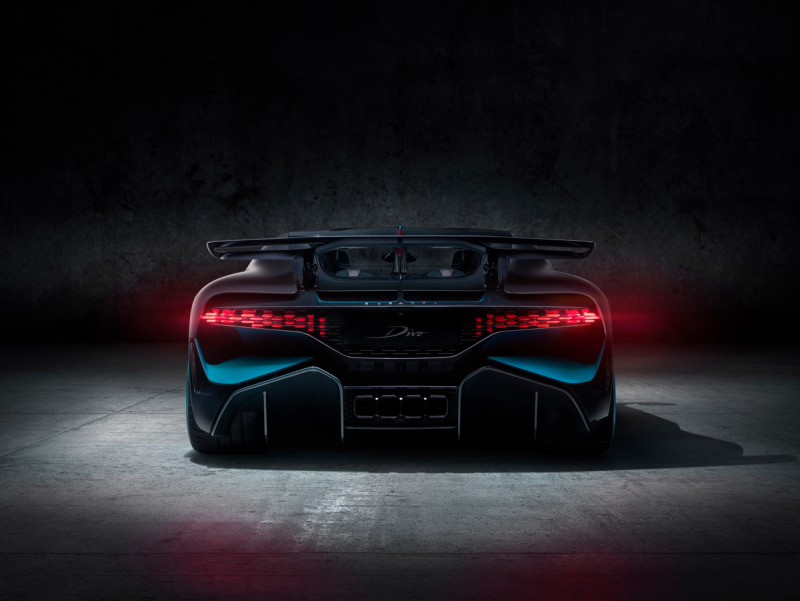
1 Véhicule proche du véhicule de série – non soumis à la directive 1999/94/CE, la réception par type n’étant pas encore disponible 2 Consommation de carburant, en l/100 km : cycle urbain : 35,2 / cycle extra-urbain : 15,2 / cycle mixte : 22,5 ; émissions de CO2 en cycle mixte : 516 g/km ; classe énergétique : G
-Ends-
Images Bugatti Automobiles S.A.S
